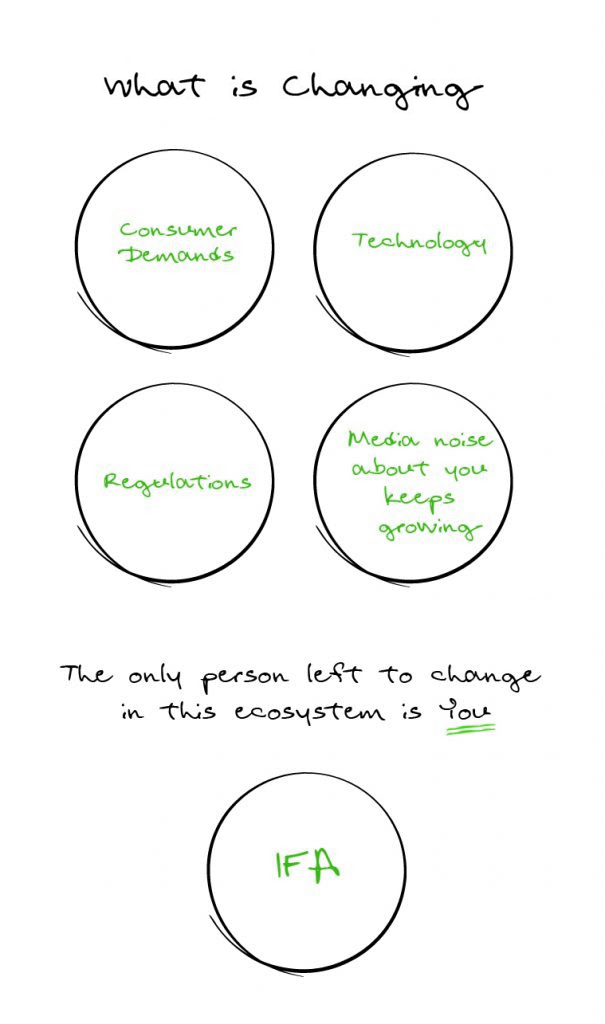Let's co-create your success story


Thank you for your interest!
One of my colleagues will be in touch with you shortly.


A respected entrepreneur with 25+ years of Experience, Amar Pandit is the Founder of several companies that are making a Happy difference in the lives of people. He is currently the Founder of Happyness Factory, a world-class online investment & goal-based financial planning platform through which he aims to help every Indian family save and invest wisely. He is very passionate about spreading financial literacy and is the author of 4 bestselling books (+ 2 more to release in 2020), 8 Sketch Books, Board Game and 700 + columns.
January 28, 2020 | 7 Minute Read
I was speaking with a group of IFA’s who asked me “Sir, What is that one thing that we should be doing in 2020 and beyond?”. I have reproduced my response to them below but first and foremost, take a look at this sketch.

The sketch attempts to say that Change will happen and the success of an IFA will lie whether he/she is able to adapt or rather embrace change. Just think about the change that has happened in the industry from August 1, 2009, onwards. The three biggest causes of IFA anxiety have been Regulation, Revenue and Robos (I will write a separate post on this one in the future) but for now, the message is that change is happening at an exponential rate in the industry.
Now think about this sketch, “What is Changing.”

Preparing yourself and your team for change.
Now you might ask What do you mean by preparing me and my team for change? First and foremost accept that what has worked for you so far will not work the same way in the future and that you need to change. Accepting this is half the battle won. Once you have taken the decision to change, first define your business goals.
Ask yourself “What is it that must happen by December 31st, 2020?” Though I can get you to set your short Term, Mid Term and Long Term goals, let’s first focus on the foundation and look at what must happen in the short run keeping the long term in mind.
What are my business goals? I have given below some of the broad challenges that you can think about and translate into your own goals:
Some of the business goals I have seen are:
Once you have defined your business goals, the next step is to realistically look at where you are and what change you need to bring about in your existing business.
Ask yourself the following?
a. What do I need to achieve my business goals (Team, Technology, Time, Capital and so on)?
b. What are the gaps that I have and how do I intend to fill the gap?
For example, let’s say your goal is to Add New Assets of Rs.25 Crore in the next year. The fastest thing to do is to look at your existing clients and figure out if you have 100% of Client Assets. If you already have, then you will grow by adding new clients. In each case whether through existing or new clients, your actions will be different and where you focus your time will differ completely.
In the case of Existing Clients, your first priority will be to set up a meeting with each of them. Before you do this, you will need to equip yourself to have a meaningful conversation with your clients. Thus the key will be to learn a New Skill. In the case of New Clients, you will need to focus on meeting the right set of ideal prospects. Like I have mentioned earlier the biggest source of leads is Existing Clients and Centres of Influence. This means that you still need to meet with Existing Clients but with a different conversation. I will cover Best Practices of Referrals in a separate column but for now, the point to understand is you have to quickly identify high impact action points.
c. What are the critical areas in which I need to change? (The most important question)
For most IFAs, the answer is very simple “Learn Goal-Based Investing and have a meaningful conversation with your Prospects and Clients.”
This is an extremely important area of change as it redefines the way you have done business so far. You will need to learn the new process to communicate with your prospects and clients and guide them to make wise investments.
Every IFA will do well to understand the wise thoughts of (now retired) Harvard Professor John Kotter . Prof.Kotter wrote “Management is about coping with complexity. Leadership, by contrast, is about coping with change. What leaders really do is prepare organizations for change and help them cope as they struggle through it.”
I hope you loved this post. Feel free to share it with your fellow IFA colleagues and friends.
My objective here is to add real value to as many IFAs as possible and help you build the wealth management firm of the future. Let me know your thoughts and if there any topics that you would like me to cover.
What do you think is the biggest problem of most firms in our industry/profession? Can you take a guess at what the answer might be? Take a shot. I have posed this question t ....Read More
20 December, 2022 | 5 Minute Read
We are all leaders...Every single one of us...But who do you think the toughest person to lead is? Take some time to reflect on this answer. Who do you think that is?
12 September, 2023 | 6 Minute Read
Are Successful people only those who have High Networth? I am not using Highest otherwise Mukesh Ambani will be the only successful person in the country. By the way, I totally di ....Read More
21 July, 2020 | 5 Minute Read
I recently visited a renowned IFA (thousands of clients and ₹1000 Crore of Assets) in his Mumbai office and he told me something very interesting. “I now realize why you never ....Read More
3 January, 2020 | 6 Minute Read
There is a question that I asked many of you. The surprising part was that no one got the answer. The answer might not be very obvious because of the way we treat this important cl ....Read More
27 June, 2023 | 5 Minute Read



Listen to the article.
Pause audio.
Resume audio.


One of my colleagues will be in touch with you shortly.
Stay ahead of the curve in adopting the best practices and strategies for your business.

You have been added to our mailing list and will update you about our latest blog posts.

0 Comments